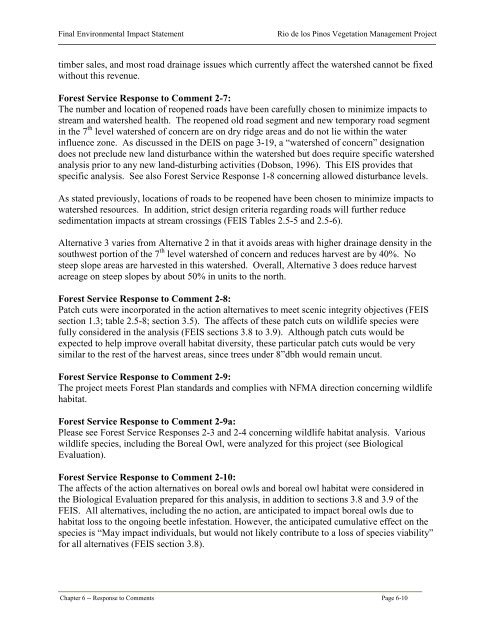Final Environmental Impact Statement Rio de los Pinos Vegetation ...
Final Environmental Impact Statement Rio de los Pinos Vegetation ...
Final Environmental Impact Statement Rio de los Pinos Vegetation ...
You also want an ePaper? Increase the reach of your titles
YUMPU automatically turns print PDFs into web optimized ePapers that Google loves.
<strong>Final</strong> <strong>Environmental</strong> <strong>Impact</strong> <strong>Statement</strong> <strong>Rio</strong> <strong>de</strong> <strong>los</strong> <strong>Pinos</strong> <strong>Vegetation</strong> Management Project<br />
timber sales, and most road drainage issues which currently affect the watershed cannot be fixed<br />
without this revenue.<br />
Forest Service Response to Comment 2-7:<br />
The number and location of reopened roads have been carefully chosen to minimize impacts to<br />
stream and watershed health. The reopened old road segment and new temporary road segment<br />
in the 7 th level watershed of concern are on dry ridge areas and do not lie within the water<br />
influence zone. As discussed in the DEIS on page 3-19, a “watershed of concern” <strong>de</strong>signation<br />
does not preclu<strong>de</strong> new land disturbance within the watershed but does require specific watershed<br />
analysis prior to any new land-disturbing activities (Dobson, 1996). This EIS provi<strong>de</strong>s that<br />
specific analysis. See also Forest Service Response 1-8 concerning allowed disturbance levels.<br />
As stated previously, locations of roads to be reopened have been chosen to minimize impacts to<br />
watershed resources. In addition, strict <strong>de</strong>sign criteria regarding roads will further reduce<br />
sedimentation impacts at stream crossings (FEIS Tables 2.5-5 and 2.5-6).<br />
Alternative 3 varies from Alternative 2 in that it avoids areas with higher drainage <strong>de</strong>nsity in the<br />
southwest portion of the 7 th level watershed of concern and reduces harvest are by 40%. No<br />
steep slope areas are harvested in this watershed. Overall, Alternative 3 does reduce harvest<br />
acreage on steep slopes by about 50% in units to the north.<br />
Forest Service Response to Comment 2-8:<br />
Patch cuts were incorporated in the action alternatives to meet scenic integrity objectives (FEIS<br />
section 1.3; table 2.5-8; section 3.5). The affects of these patch cuts on wildlife species were<br />
fully consi<strong>de</strong>red in the analysis (FEIS sections 3.8 to 3.9). Although patch cuts would be<br />
expected to help improve overall habitat diversity, these particular patch cuts would be very<br />
similar to the rest of the harvest areas, since trees un<strong>de</strong>r 8”dbh would remain uncut.<br />
Forest Service Response to Comment 2-9:<br />
The project meets Forest Plan standards and complies with NFMA direction concerning wildlife<br />
habitat.<br />
Forest Service Response to Comment 2-9a:<br />
Please see Forest Service Responses 2-3 and 2-4 concerning wildlife habitat analysis. Various<br />
wildlife species, including the Boreal Owl, were analyzed for this project (see Biological<br />
Evaluation).<br />
Forest Service Response to Comment 2-10:<br />
The affects of the action alternatives on boreal owls and boreal owl habitat were consi<strong>de</strong>red in<br />
the Biological Evaluation prepared for this analysis, in addition to sections 3.8 and 3.9 of the<br />
FEIS. All alternatives, including the no action, are anticipated to impact boreal owls due to<br />
habitat <strong>los</strong>s to the ongoing beetle infestation. However, the anticipated cumulative effect on the<br />
species is “May impact individuals, but would not likely contribute to a <strong>los</strong>s of species viability”<br />
for all alternatives (FEIS section 3.8).<br />
Chapter 6 -- Response to Comments Page 6-10
















